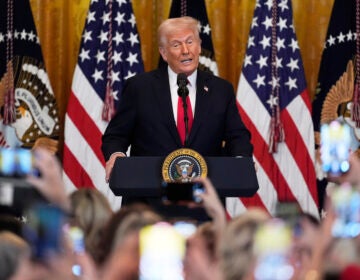U.S. taps Philadelphia, Camden to help close digital divide
 Photo via ShutterStock) " title="shutterstock_127818968" width="1" height="1"/>
Photo via ShutterStock) " title="shutterstock_127818968" width="1" height="1"/>
(Photo via ShutterStock)
More than 90 percent of families making more than $100,000 a year have broadband at home. More than half of families making $25,000 or less do not.
In an effort to close that digital divide, the White House announced a new broadband access initiative, and Philadelphia and Camden are among 27 cities getting the first chance to try it.
Called ConnectHome, the program will include digital literacy training and discounted or free Internet service for families with school-age children who live in public housing.
Asia Coney, the president of the resident advisory board at the Philadelphia Housing Authority, estimated that only about a quarter of residents there have broadband.
“Quite frankly, without it, the children don’t get the assistance that they need with their homework,” she said. “And pretty soon, if you’re not Internet-savvy you probably won’t even be able to shop.”
The details are still being worked out, but one plan is for Wilco Electronic Systems, one of the Internet service providers for the PHA, to add new wired broadband connections for residents by the fall. Right now, the company’s Internet is available to customers only through a hot-spotlike service.
“That jack in the wall that was formerly just cable entertainment is now so much more than that,” said Bridgitte Daniel, the head of Wilco. “It’s now the pipeline that gives people opportunities for jobs, education, [and] better health care.”
The cost for the cable broadband is likely to be $15 to $20 a month, roughly half of an average bill.
Daniel said Wilco currently has just 700 PHA wireless subscribers, with few in Promise Zone areas. According to a representative of the regional Department of Housing and Urban Development, more than 5,700 households in Philadelphia are eligible for help to get broadband under the ConnectHome program.
John Horrigan of the Pew Research Center, who has studied why people haven’t adopted broadband, said it’s important that the national program doesn’t just include financial assistance.
“Cost is certainly part of it, he said. “But a good number just don’t understand how it might be relevant to their lives. And a good number simply don’t know how to use the Internet or initiate online sessions with a computer.”
In a digital world increasingly dominated by mobile, he said, broadband on larger screens is still essential, since those offer a more substantive way to interact with information and create content. People who only have smartphones as a way of accessing the Internet are also vulnerable to breaks in service.
“About half of them have had to cancel or suspend service due to financial constraints,” Horrigan said of the smartphone-reliant population. “About half also occasionally at least reach the maximum data limit allowed by their smartphone plan, so they have to curtail usage.”
WHYY is your source for fact-based, in-depth journalism and information. As a nonprofit organization, we rely on financial support from readers like you. Please give today.




